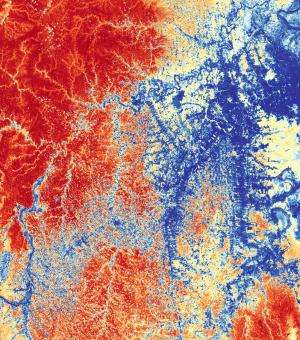Mapping reveals targets for preserving tropical carbon stocks

A new high-resolution mapping strategy has revealed billions of tons of carbon in Peruvian forests that can be preserved as part of an effort to sequester carbon stocks in the fight against climate change. Tropical forests convert more carbon from the atmosphere into biomass than any other terrestrial ecosystem on Earth. However, when land is used for agriculture, as a wood source, or for mining, carbon is often released into the atmosphere where it contributes to climate change. Tropical deforestation and forest degradation account for about 10 percent of the world's carbon emissions annually.
There remain major challenges to conserving the carbon that's stored in these tropical landscapes on a national and international scale. A team led by Carnegie's Greg Asner developed a new high-resolution approach for prioritizing carbon conservation efforts throughout tropical countries. Their findings are published the week of November 10 in the Proceedings of the National Academy of Sciences. The team of authors emphasized that the low cost of conducting their project means that the same approach can be rapidly implemented in any country, thereby supporting both national and international commitments to reduce and offset carbon emissions.
Many of the geographic details about the carbon that's stored in tropical forest ecosystems remain unknown. In order for people involved in conservation efforts to select new areas in which carbon stocks can be best protected and enhanced, detailed information on which areas would make the best targets for protection are necessary. This means understanding each landscape's climate, topography, geology, and hydrology.
Using advanced three-dimensional forest mapping data provided by the Carnegie Airborne Observatory (CAO), integrated with satellite imaging data, the team was able to create a map of carbon density throughout the 128 million hectare (320 million acre) country of Peru, at a resolution of one hectare (2.5 acres).
"We found that nearly a billion metric tons of above-ground carbon stocks in Peru are at imminent risk for emission into the atmosphere due to land uses such as fossil fuel oil exploration, cattle ranching, oil palm plantations and gold mining," Asner said. "The good news is that our high-resolution mapping was able to identify three strategies for offsetting these upcoming emissions."
The team determined that there are opportunities to establish additional protected areas in some lowland Amazonian regions of Peru, where they found very high carbon densities, as well as in the so-called sub-montane region, which exists between the lowland Amazonian and Andean highland regions. Together the lowland Amazonian and sub-montane forests offer about 30 million hectares for potential new protected forest areas, which may be able to store close to 3 billion metric tons of carbon.
"Research is necessary to determine the exact state of our forests," stated Manuel Pulgar-Vidal, Peru's Minister of Environment, "For that, the Carnegie Institution, with the support of the Peruvian Environment Ministry, has developed the first high-resolution map of Peru's carbon stocks. This new map provides the evidence needed to start negotiating in the carbon market at a bigger scale. Our government is also studying carbon stocks in the soil, and is doing a forest inventory, and we have a forest investment program. These initiatives will better prepare us to face changes in land use."
The team also asserted that there are further opportunities for offsetting future emissions by improving enforcement in areas that are already designated for protection of carbon stocks. According to their research, the majority of already protected carbon stocks exist only in 10 parks and reserves, and just four of these are fully enforced.
"Transitioning partially protected preserves to fully protected ones would help to counterbalance a great deal of the carbon that is expected to be lost due to land use in the near future," Asner said.
More information: Targeted carbon conservation at national scales with high-resolution monitoring, PNAS, www.pnas.org/cgi/doi/10.1073/pnas.1419550111
Journal information: Proceedings of the National Academy of Sciences
Provided by Carnegie Institution for Science



















